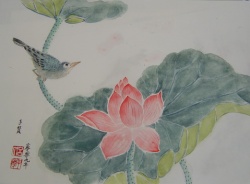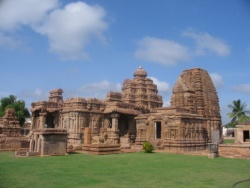Difference between revisions of "The Treasures of the Theravada"
(Created page with "thumb|250px| <poem> Recovering the Riches of Our Tradition by Gil Fronsdal ~ 1995 At a vipassana teachers’ meeting at Spirit Rock Center in Septemb...") |
|||
| Line 60: | Line 60: | ||
[http://www.insightmeditationcenter.org/books-articles/articles/the-treasures-of-the-theravada/ www.insightmeditationcenter.org] | [http://www.insightmeditationcenter.org/books-articles/articles/the-treasures-of-the-theravada/ www.insightmeditationcenter.org] | ||
[[Category:Buddhist Terms]] | [[Category:Buddhist Terms]] | ||
| − | [[Category:Theravada Buddhism]] | + | [[Category:Theravada Buddhism]]<br/>This material is licensed under the [http://creativecommons.org/licenses/by-nc-nd/3.0/ Creative Commons License]. You may make and/or distribute copies, provided that you do so freely without cost, follow the guidelines of the license, and this notice is included with all copies. |
Revision as of 14:47, 25 October 2013
Recovering the Riches of Our Tradition
by Gil Fronsdal ~ 1995
At a vipassana teachers’ meeting at Spirit Rock Center in September 1993, the thirty or so attending teachers were asked if they considered themselves teachers of Theravada Buddhism. Surprisingly, of this group only three clearly identified themselves with the tradition from which their practice came, that is, the ancient Theravada school of Buddhism that survives predominantly in Southeast Asia. At similar meetings at the Insight Meditation Society in Barre, Massachusetts, most of the attending vipassana teachers likewise did not consider themselves Theravada teachers. In September 1994, the dozen teachers directly involved-with teaching at Spirit Rock debated whether or not Spirit Rock should be considered a Theravada center. After the various reasons for and against such an identification were expressed (e.g., the benefits of being connected to a specific lineage versus the difficulties of relating to the life-denying, other-worldly and dua1istic aspects of the tradition), it became clear that the majority of the teachers did not want such a label, preferring to see the center as inspired by, but independent from, the Theravada tradition. Yet, as Spirit Rock, in Marin county, California, is growing to be one of the largest vipassana centers in America, this preference is likely to have long-term consequences for the development of both Theravada Buddhism and the vipassana meditation movement in the West.
The ambivalence of many American vipassana students and teachers towards some aspects of the Southeast Asian tradition is reflected in the very labels “vipassana student” and “vipassana teacher.” Vipassana refers to a particular practice of mindfulness found within Theravada Buddhism. In contrast, it is unusual for students of Zen and Tibetan Buddhism to identify themselves by a specific practice found within their respective traditions. Rather than calling themselves “zazen students” or “Mahamudra students,” they seem quite comfortable calling themselves students of Zen Buddhism or Tibetan Buddhism. While there are now many vipassana students in the West, hardly any call themselves students of Theravada Buddhism, let alone Theravadan Buddhists.
The strong identification of American vipassana students with the practice, instead of the Theravada tradition, is to a great degree the result of a conscious decision by the early American vipassana teachers. These teachers wanted to offer an easily accessible, simple but profound practice freed from much of its Southeast Asian Buddhist context. In part, they were continuing the work of their own Asian teachers: Achaan Buddhadasa who renounced the rites and rituals of the modern Theravada and returned for inspiration to its ancient roots; Mahasi Sayadaw whose over 100 centers focused almost solely on mindfulness training; and U Ba Khin and S.N. Goenka who have taught vipassana worldwide as a sufficient technique for discovering truth: As Jack Kornfield, a senior Western vipassana teacher has said, “We wanted to offer the powerful practices of insight meditation, as many of our teachers did, as simply as possible without the complications of rituals, of robes, chanting and the whole religions tradition.” A great part of the popular success of vipassana in the West may be a consequence of this decision.
Now that vipassana practice seems to be firmly rooted in America, I think it is time for the vipassana community to become better informed about the tradition from which it came. As both a student and a teacher of insight meditation, I raise this issue because I am concerned that a full spiritual life is not found through vipassana practice alone. Furthermore I am concerned that some of the riches of the Theravada tradition will be lost to Western students who are only learning vipassana meditation.
Since vipassana is seldom presented within its wider Theravada context, vipassana students often turn to other Buddhist traditions to provide needed instruction. For example, the Theravada teachings on death and dying are seldom taught. As a result, many vipassana students have studied and adopted the much more readily available Tibetan teachings (e.g., from Sogyal Rinpoche’s national best-selling book The Tibetan Book Of Living and Dying). The Theravada tradition has a very different and wonderfully simple perspective on death and dying that does not involve the various intermediary realms found in Tibetan Buddhism.
In the last few years, a number of vipassana students have also been attracted to the non-dual teachings of various Mahayana traditions and even of the Advaita Vedanta Hindu tradition. These students may not even be aware of the profound non-dual teaching and practice styles that exist both in some of the classic Theravada scriptures (e.g., in the Atthakavagga) and among some of the living forest-monk traditions in Thailand (e.g., Achaan Buddhadasa and AchaanCha).
Many vipassana practitioners have distanced themselves from Theravada Buddhism because they equate that tradition with its more orthodox monastic and doctrinal expressions in Southeast Asia. But by rejecting it because of its world-renouncing, literalist, dualistic, male-centered and at times misogynist tendencies, they often lose sight of other important offerings.
Today most Western lay teachers offer an alternative to such orthodoxy. Rather than stressing-world-renunciation, they stress engagement with, and freedom within the world. Rather than rejecting the body, these Western teachers embrace the body as part of the wholistic field of practice. Rather than stressing ultimate spiritual goals such as full enlightenment, ending the cycles of rebirth, or attaining the various stages of sainthood, many Western teachers tend to stress the immediate benefits of mindfulness and untroubled, equanimous presence in the midst of life’s vicissitudes. Rather than emphasizing spiritual and psychological purification, most western teachers focus on the transformation of one’s relationship to one’s emotions and to one’s inner and outer world. This means that instead of aiming at the elimination of, say, anger, the practitioner is directed to see the anger clearly without either acting it out or suppressing it. In addition, many Western vipassana teachers are reevaluating the ultimate goal of enlightenment or simply placing less importance on it than do most teachers in Southeast Asia.
The Western vipassana movement is also being profoundly changed by democracy, feminism and contact with other Buddhist traditions. In striking comparison to the predominance of male monastic teachers in Southeast Asia, almost half of all vipassana teachers in the United States are lay women. While the Asian Theravada tradition has a rich history of female participation, over and over again it is the male monastics who have recorded its history, doctrines and practices. The voices of the women practitioners have largely been lost. Now the strong female practitioners and teachers in the West (Sharon Salzberg, Michele McDonald-Smith, Christina Feldman and Sylvia Boorstein, to name a few) are rejuvenating the tradition with perspectives that have often been marginalized.
It is perhaps Western women who have found the least sustenance from the monastic sangha in Southeast Asia. The lack of a nuns’ order has meant that women have had no access to a monastic status comparable to the monks. While there are several female meditation teachers in Southeast Asia, for the most part there is a lack of will to empower women. Within the monasteries, women are mostly relegated to third class status, at best. In such environments there is an absence of inspiration for women either through living role models or through religious imagery.
Feeling a need for female iconography to support their practice, many vipassana students have adopted Mahayana bodhisattva deities, such as Kuan-yin, Tara and other female forms of the compassionate Avalokitesvara. At Spirit Rock Center a Thai Buddha statue is on the central altar, but prominently displayed in the meditation hall are a Chinese statue of Kuan-yin, a Tibetan thangka of a female manifestation of Avalokitesvara, and a Hindu statue of a many-armed female deity. While it is not necessarily problematic to draw on other traditions in this way, it is useful to note that these bodhisattvas and gods originated from metaphysical and cosmological understandings very different from those of the less theistic Theravada tradition.
Rather than turning to other traditions, Western vipassana practitioners could just as well recover the strong female images within the Theravada tradition such as Mahapajapati Gotami, the founder of the order of Buddhist nuns and the foster mother of the Buddha. In the Apadana, the only text of the Theravada canon (the Tipitika) still not translated completely into English; the enlightened Gotami is depicted as a female counterpart to the Buddha. For every image of the Buddha in Western vipassana meditation halls, there could be installed an image of Mahapajapati Gotami as the paradigm of women’s potential to full religious awakening.1 JonathanWalters, one of the few Buddhist scholars to have studied the Theri-Apadana, has argued that it is the product of a period when women had strong and important voices within the Theravada tradition.2
In Sri Lanka the feminine can be found in the beautiful saying, Amma gedara Budun, “the mother is the Buddha of the home,” and the Buddha himself is sometimes referred to as Ama maniyo, “the eternal mother.” In the Theri-Apadana, Gotami, who was the nursemaid of the Buddha, refers to the Buddha as a mother who nursed her with Dharma-milk.
Furthermore, in the literature of the Sri Lankan Theravada there are stories of how, many lifetimes ago, Shakyamuni received his initial impulse to attain Buddhahood from his mother. Whereas Shakyamuni is ordinarily described as attaining Buddhahood through his own efforts only, here his mother is described as “giving” him Buddhahood.3 In ignoring this female imagery and literature, we miss the opportunity to resurrect the silent female voices of old.
When it comes to meditation practices, Theravada Buddhism has a much more rich and varied repertoire than is obvious from what is offered at Western or even Southeast Asian vipassana centers. While not as elaborate as some Tibetan visualization practices, there are a wide variety of Theravada meditations involving mental imaging of buddhas; bodhisattvas, arhats, celestial realms, corpses, and the primary colors and elements.
While not as carefully collected, organized and commented on as Japanese Zen Koans, there is a Theravada tradition of practicing with a dharma, question or riddle, e.g., “What is the place that does not come or go or stand still?” “If the Buddha was never born, where is he now?” or “How can we live so as not to be seen by the king of Death?” The monastic forest traditions of Thailand (e.g., among the lineages of Achaan Mun, Achaan Maha Boowa and Achaan Cha) have also preserved a variety of practices using sacred mantras for concentration and insight; sometimes we find these mantras used in conjunction with rituals of protection or exorcism. In some Burmese and Thai meditation traditions there are practices that involve focusing on charka or energy centers in the body and other practices involving energy transmission from teacher to student (e.g., among the U Ba Khin tradition in Burma and at Wat Paknam in Thailand). While the practice of vipassana might be highly effective, it would be a pity to ignore this wide variety of skillful means.
By focusing on the relatively individualistic insight meditation practice, the Western vipassana community has also largely ignored the communal practices of Theravada Buddhism. The tradition offers a whole range of ritual practices which help foster community, connect us with the land on which we live and mark birth, death and the seasons. The collective decision-making and reconciliation practices that have benefited the monastic community for centuries could be invaluable for extending our practice from our cushions to our communities.
Recently, many diverse Theravada practices were brought to Spirit Rock through the visit of Achaan Jumnien, a sixty-year-old monk from the jungles of Southern Thailand. In the course of nine days he taught thirty different practices. These included chakra practices (opening of the wisdom-eye and the heart center), skeleton practices (on the nature of the body), and meditations with the elements of earth, air, fire, water and space. He trained people to understand emptiness by resting in what he called the “Original Mind” or the “Natural State” and he offered practices unifying participants’ consciousnesses with his own. He also performed many kinds of blessings, described exorcisms, taught chants, and offered protection rituals, visualizations and vows (including bodhisattva vows, practice vows and refuge vows). Throughout, he emphasized that freedom and emptiness and joy can be found in all circumstances. And this in only one week from one Theravada teacher!
It is essential to understand that “Theravada Buddhism” has no fixed definition. If we claim that the only true and complete locus for the tradition is the monastic sangha, then it is all too easy to undervalue the religious expression and practices of the “Theravada” laity. Regardless of how we choose to define Theravada Buddhism, we do not want to accept the label “Hinayana” for the tradition. The term itself is even more pejorative than the usual English translations of “the Small Vehicle” or the “the Lesser Vehicle.” Hinayana could more literally be translated as the “crummy or lousy vehicle.” (The Monier-Williams Sanskrit-English Dictionary gives “inferior” and “defective” as translations for Hina.) When the word “Hinayana” was first used in Buddhist India it did not refer to any particular school of Buddhism, but rather to a selfish and arrogant attitude of particular practitioners. It is mostly through the quirks of history that it became a label used to contrast the Theravada with the Mahayana tradition.
It is also commonly assumed that the Theravada has different goals from the Mahayana. That is, the Theravada teaches the path to arhathood (a path to full enlightenment which neither develops all the qualities of a Buddha nor cultivates a vow to save all beings), while the Mahayana teaches the bodhisattva path to buddhahood that involves the altruistic vow to save all beings. Though often overlooked by writers on Theravada Buddhism the bodhisattva path has remained available within the Theravada tradition from before the rise of the Mahayana down to the present time. A small but significant number of Theravadan monks and teachers, some of whom were popularly considered to be arhats, have chosen this difficult option as their own.4
In conclusion, it is my hope that those of us within the Theravada tradition will reflect more on our relationship to both the older Asian tradition and to the teachings and forms we are creating here in the West. While it could be that the West gives birth to what may eventually be known as “Vipassana Buddhism,” it would be a pity if we do so without first exploring the depth and richness found in the almost two-thousand-year-old Theravada tradition. I believe it is important to remain connected to that tradition and to specific lineages within it. This will provide us with a reference to help us remain conscious about the choices we are making in the West. It is easily possible that without strong roots in the older tradition the American vipassana movement will lose its Buddhist identity, melding into our Judeo-Christian environment.
1 Further.information on Mahapajapati can be found in Susan Murcott’s The First Buddhist Women published by Parallax Press.
2 Jonathan S. Walters, “A Voice from the Silence: the Buddha’s Mother’s Story,” in History of Religions, Vol. 33, #4, 1994; pp·358-379.
3 Richard Gombrich, “Feminine Elements in Sinhalese Buddhism,” in Wiener Zeitschrift fur die Kunde Sudasiens 16 (1972): 67-93.
4 More information on the bodhisattva path within Theravada Buddhism can be found in Walpola Rahula’s article “The Bodhisattva Ideal in Theravada and Mahayana” in his book Zen and the Taming of the Bull: Towards the Definition of Buddhist Thought.
This article was originally published in Inquiring Mind, Vol 12(1), 1995
Source
www.insightmeditationcenter.org
This material is licensed under the Creative Commons License. You may make and/or distribute copies, provided that you do so freely without cost, follow the guidelines of the license, and this notice is included with all copies.




